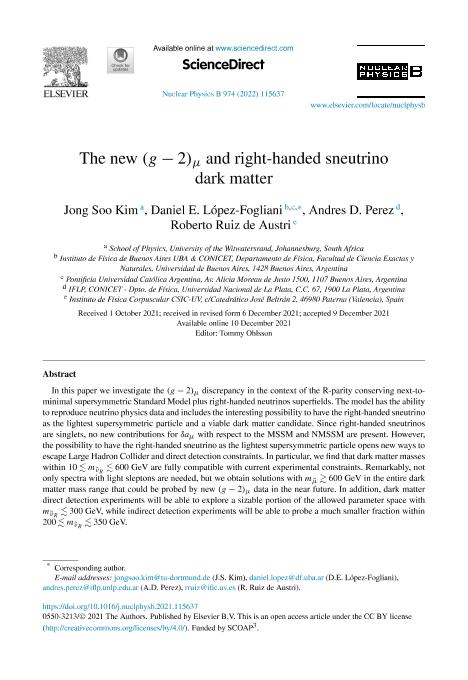Mostrar el registro sencillo del ítem
dc.contributor.author
Kim, Jong Soo
dc.contributor.author
Lopez, Daniel Elbio

dc.contributor.author
Perez, Andres Daniel

dc.contributor.author
Ruiz de Austri, Roberto
dc.date.available
2023-08-23T19:09:05Z
dc.date.issued
2022-01
dc.identifier.citation
Kim, Jong Soo; Lopez, Daniel Elbio; Perez, Andres Daniel; Ruiz de Austri, Roberto; The new (g−2)μ and right-handed sneutrino dark matter; Elsevier Science; Nuclear Physics B; 974; 1-2022; 1-23
dc.identifier.issn
0550-3213
dc.identifier.uri
http://hdl.handle.net/11336/209149
dc.description.abstract
In this paper we investigate the (g−2)μ discrepancy in the context of the R-parity conserving next-to-minimal supersymmetric Standard Model plus right-handed neutrinos superfields. The model has the ability to reproduce neutrino physics data and includes the interesting possibility to have the right-handed sneutrino as the lightest supersymmetric particle and a viable dark matter candidate. Since right-handed sneutrinos are singlets, no new contributions for δaμ with respect to the MSSM and NMSSM are present. However, the possibility to have the right-handed sneutrino as the lightest supersymmetric particle opens new ways to escape Large Hadron Collider and direct detection constraints. In particular, we find that dark matter masses within 10≲mν˜R≲600 GeV are fully compatible with current experimental constraints. Remarkably, not only spectra with light sleptons are needed, but we obtain solutions with mμ˜≳600 GeV in the entire dark matter mass range that could be probed by new (g−2)μ data in the near future. In addition, dark matter direct detection experiments will be able to explore a sizable portion of the allowed parameter space with mν˜R≲300 GeV, while indirect detection experiments will be able to probe a much smaller fraction within 200≲mν˜R≲350 GeV.
dc.format
application/pdf
dc.language.iso
eng
dc.publisher
Elsevier Science

dc.rights
info:eu-repo/semantics/openAccess
dc.rights.uri
https://creativecommons.org/licenses/by/2.5/ar/
dc.subject
SUPERSYMMETRY
dc.subject
DARK MATTER
dc.subject
SNEUTRINO
dc.subject.classification
Física de Partículas y Campos

dc.subject.classification
Ciencias Físicas

dc.subject.classification
CIENCIAS NATURALES Y EXACTAS

dc.title
The new (g−2)μ and right-handed sneutrino dark matter
dc.type
info:eu-repo/semantics/article
dc.type
info:ar-repo/semantics/artículo
dc.type
info:eu-repo/semantics/publishedVersion
dc.date.updated
2023-07-07T18:03:08Z
dc.journal.volume
974
dc.journal.pagination
1-23
dc.journal.pais
Países Bajos

dc.journal.ciudad
Amsterdam
dc.description.fil
Fil: Kim, Jong Soo. University of the Witwatersrand; Sudáfrica
dc.description.fil
Fil: Lopez, Daniel Elbio. Consejo Nacional de Investigaciones Científicas y Técnicas. Oficina de Coordinación Administrativa Ciudad Universitaria. Instituto de Física de Buenos Aires. Universidad de Buenos Aires. Facultad de Ciencias Exactas y Naturales. Instituto de Física de Buenos Aires; Argentina
dc.description.fil
Fil: Perez, Andres Daniel. Consejo Nacional de Investigaciones Científicas y Técnicas. Centro Científico Tecnológico Conicet - La Plata. Instituto de Física La Plata. Universidad Nacional de La Plata. Facultad de Ciencias Exactas. Instituto de Física La Plata; Argentina
dc.description.fil
Fil: Ruiz de Austri, Roberto. Consejo Superior de Investigaciones Científicas; España
dc.journal.title
Nuclear Physics B

dc.relation.alternativeid
info:eu-repo/semantics/altIdentifier/doi/http://dx.doi.org/10.1016/j.nuclphysb.2021.115637
Archivos asociados
